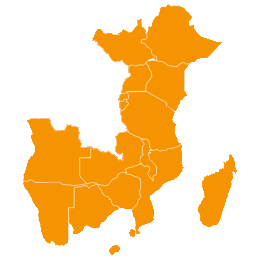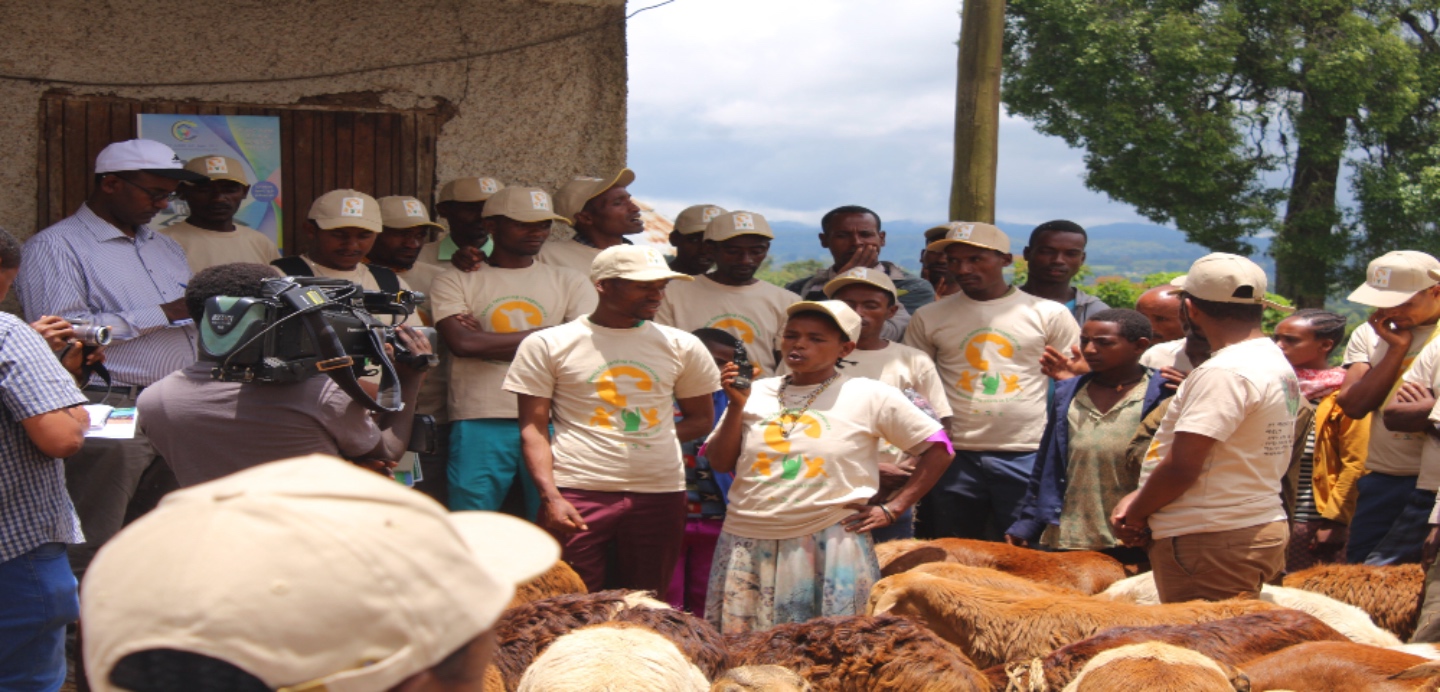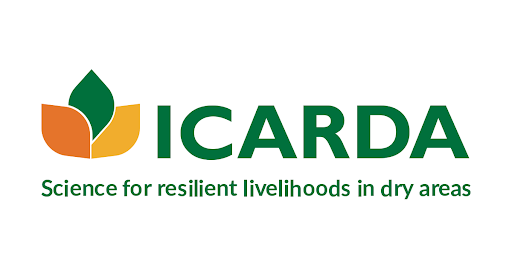Sheep Fattening
“I was a village girl who couldn’t speak much in front of men. After becoming a group member, I have become a girl with high self-esteem and confidence”
Tesfanesh Demissie, an 18 year old girl from Anicha-Sedicho kebele of Doyogena district, sheep fattening youth group memberBACKGROUND
The majority of unemployed youth in Ethiopia live in rural areas, where farming is the traditional livelihood. Because of high population density, parts of Ethiopia’s highlands face a severe shortage of land. As a result, solutions must consider interventions that can be undertaken on small farms or public lands.
WHAT’S INVOLVED
A start-up package: Each participant was provided a free fattening ram, salt-lick block, feed trough and a watering trough.
Youth groups: Overseen by CBBP cooperatives and mentored by a champion farmer, youth are trained in entrepreneurship as well as improved sheep fattening technologies and practices.
Communities of Practice (CoP): CoP develop actionable ideas, knowledge and policies to promote innovations in sheep fattening. Members include researchers, key sheep value-chain actors and governments.
Open field days : Youth groups organized open field days to disseminate to farmers in their communities improved fattening practices. All activities were free and included trainings, experience exchanges, sheep vaccination and deworming and castration services.
EXPLORE THIS SOLUTION
The solution can offer:
- Increased entrepreneurship, facilitated by youth promoters, as a sustainable way to ensure livelihoods
- Methods to increase rams’ daily weight gain using local resources, as disseminated by youth promoters
- Increased livelihoods from being able to sell sheep at a higher price than sheep fattened by traditional methods

Countries involved
Ethiopia
Project partners
International Center for Agricultural Research in the Dry Areas (ICARDA); Ethiopia’s Southern Agricultural Research Institute (SARI); Amhara Regional Agricultural Research Institute (ARARI)
Project dates
2018-2019
Share this solution
Bookmark this solution
BookmarkShow Full Solution
Summary
To improve incomes from sheep fattening in rural Ethiopia, ICARDA took a new approach that leveraged youth as influencers to scale up adoption of improved sheep fattening technology and practices. Young people received a start-up package, participated in youth group trainings, were supported by a community of practice and disseminated their knowledge by organizing field days. This approach has continued in the communities despite the project ending. Thus, ICARDA continues to provide support and trainings to youth groups.
Challenge/Problem
Most of the unemployed youth in Ethiopia live in rural areas, where farming is the traditional livelihood. Because of high population density, parts of Ethiopia’s highlands face a severe shortage of land. As a result, solutions must consider interventions that can be undertaken on small farms or public lands. Sheep fattening is a long-standing practice in Ethiopia, perceived to be a low-risk activity and more profitable than raising large ruminants. A financial feasibility analysis showed that in Ethiopia, rams fattened by new techniques accrue higher net profit than animals fattened by traditional techniques. However, many farmers still use the latter inducing feed scarcity, poor husbandry practices, diseases, labour shortages, poor market access, youth unemployment and land scarcity. To improve farmer incomes, this solution used an entrepreneurial, community approach: leveraging youth as influencers to scale up adoption of improved sheep fattening technology and practices.
Solution
This solution is made possible and continues to operate today through youth groups, community-based breeding programs (CBBP) and supportive communities of practice. It provides participants with a start-up package that includes a fattening ram, salt-lick block, feed trough and watering trough. Youth groups were formed in order to strengthen entrepreneurial skills and deliver training on improved technologies and practices for sheep fattening. The groups were overseen by CBBP cooperatives and mentored by a champion farmer. They were further supported by communities of practice (CoP), which develop actionable ideas, knowledge and policies to promote innovations in sheep fattening. CoPs are composed of researchers, key sheep value-chain actors, government experts and administrators.
A total of 485 youth (287 male, 198 female) participated in 44 youth groups across 29 sub-villages within six districts of the two regional states of Amhara and Southern Nations, Nationalities and Peoples' Region (SNNPR). In addition, the groups organized open field days to disseminate to farmers in their communities improved fattening practices and knowledge. All activities were free and included trainings, experience exchanges, sheep vaccinations and deworming and castration services.
To improve youths’ incomes from sheep fattening and scale up this practice among farmers in Menz, Doyogena and Bonga regions, youth were targeted as “influencers” and provided with a free start-up package, group-based technical and entrepreneurial trainings and a supportive environment. The International Center for Agricultural Research in the Dry Areas (ICARDA) started this project in partnership with Ethiopia’s Southern Agricultural Research Institute (SARI) and the Amhara Regional Agricultural Research Institute (ARARI).
In addition to increasing her income, 18-year-old Tesfanesh shared her experience: “I was a village girl who couldn’t speak much in front of men. After becoming a group member, I have become a girl with high self-esteem, confidence and entrepreneurial skills that I could promote.”
Results
The solution rendered the following results:
- Increased entrepreneurship: At least 412 youth are now fattening more than six rams per fattening cycle, and 437 youth are undertaking three to four fattening cycles per year (up from two).
- Fatter sheep: The average daily weight gain of fattening rams has increased from 56-122 to 94-198 grams (an increase of 44-67 per cent), while utilizing only locally available feed resources.
- Higher income: Participating youth were able to sell sheep at ETB 2200-4000, a price 45-70 per cent higher than the price of sheep fattened by traditional methods. Their incomes increased by an average of ETB 15000 (US$500) over the three fattening cycles of the first year.
Lessons Learned/Potential for replication
This approach of creating an enabling environment for sheep fattening and providing start-up inputs to youth has demonstrated reproducibility across 29 sub-villages in Ethiopia. Other development partners considering this solution should consider the following lessons learned:
- It’s important to emphasize the benefits and sustainability of local feeds; several farmers were disappointed because they did not receive commercial feed.
- It’s challenging to orient attitudes and mindsets towards business; some youth spend their earnings immediately without setting aside savings.
Given the success of this solution and its sustainability beyond the end of the project, other organizations operating in similar contexts may also achieve positive results by adopting this solution.
Next Steps
All original members of the youth groups are still undertaking market-oriented sheep fattening, and group membership has increased by 26 per cent. Three government bureaus have incorporated this program into their regional development plans. Going forward, youth groups will be supported in creating and legalizing farming cooperatives. In Ethiopia, when locals are sufficiently organized, legally registered and trained on a united effort, they can influence governmental plans and policies. Legally organized groups have better access to loans from microfinance institutions. This solution is enhancing women’s inclusion through increased membership of young women.
Solution Document Downloads
Solution Additional Resources
ICARDALast update: 25/05/2021



